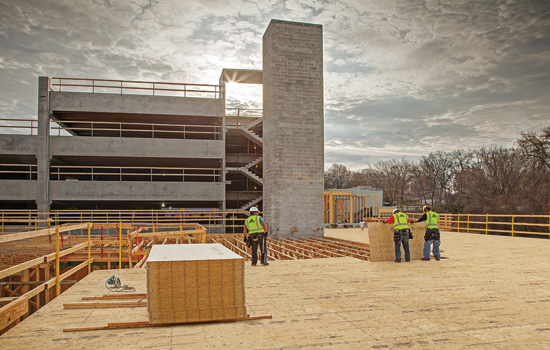Subfloor as a Hidden Asset
Learning Objectives:
- Describe the effect of a subfloor on a finished floor.
- Compare three types of sub flooring materials in terms of performance.
- Discuss the effects of moisture on the quality of a finished floor.
- Explain installation procedures of sub flooring under hardwood, ceramic tile, light metal gauge, and radiant heating flooring.
Credits:
When it comes to building assets, some of the most valuable are covered during the construction process. Such is the case with subflooring, a structural layer of support—and often the only layer—between the joists and the finished floor. Anyone with floors that squeak, creak, move, sag, or separate knows the effects of a faulty subfloor. In addition to user dissatisfaction, subpar subflooring can contribute to multiple performance failures resulting in costly callbacks, reworks, and even legal suits. Consequently, it behooves architects to understand the fine points of what constitutes a good subfloor. This article will discuss both appropriate subfloor materials and why they matter and the right installation and subfloor preparation to assure long-term floor performance. Lastly, we will discuss different finished floor installations that help to ensure optimal long-term performance.
Why Performance Matters
Everything in a structure rests on the subfloor. Once installed, it cannot be changed easily. According to a 2007 J.D. Power New Homebuilder Customer Satisfaction survey, half of all new homeowners complain about squeaky hardwood floors.
Today, the demands placed on a subfloor are growing ever more stringent. Modern floor plans and designs are putting greater demands on subfloor strength and stiffness than in years past because of details such as open floor plans and stone or granite counters. Designers are increasingly specifying high-end finishes, and they absolutely require a high-quality subfloor. Large-format ceramic tiles and thin engineered planks, for example, need a subfloor that is stiff and consistent, while wide-plank solid boards demand high moisture resistance and superior nail holding ability. Designers who are ignorant of or fail to meet these needs are setting themselves up for failures ranging from loose or cracked tiles to swollen and cupped hardwoods—problems that in turn lead to expensive and time-consuming warranty claims.

Subflooring is the key to long-term floor performance.
Photo courtesy of Huber Engineered Woods © 2014









